Buying A New UTV? Consider These 6 Factors First.

Keith Owens likes to say that if a utility vehicle (UTV) can pass muster on his farm, it will be a good fit on nearly any farming operation.
“We put ‘em through a stress test, for sure,” says Owens, who runs 60 cow-calf pairs and raises hay in central North Carolina, near Bear Creek.
Everyday chores on the farm include carting loads of mineral and feed to the cattle, building fence and hauling firewood. Owens’ two UTVs also get a work out as he continually clears brush and trees on his property to open more ground up for pasture.
“When I’m shopping for a UTV, I’m thinking about how long it’s going to last,” he says. “It’s not uncommon to run over stumps and dead trees out here, so it has to have good ground clearance and durability.”
The durability factor is the No. 1 thing farmers consider as they shop for a utility vehicle (also called a side-by-side or SXS), according to 2,326 farmers who responded to a 2017 Farm Journal national survey on UTV buying practices. Rounding out the top five factors farmers consider are price, traction, warranty and manufacturer, in that order.
“Farmers understandably have a high expectation that their UTV will hold up under harsh conditions and heavy use,” notes Mark Davey, marketing manager for John Deere Gator Utility Vehicles.
Other company spokesmen concur with Davey, and all offer specific factors they say contribute most to durability. Here is a list of six factors that came to the top.
1. Identify key tasks before you buy. If you’re in the market for a new, four-wheeled workhorse determine the specific jobs you need it to perform. Let the tasks drive how you evaluate the UTV for durability and other key factors.
2. Consider the engine size. “If you have jobs on the farm that require a lot of low-gear use, like towing, that’s going to tax the whole system, so you need an engine that can handle that strain,” advises Andrew Howard, Can-Am Off-Road media relations. “If you are going to be hauling and towing a lot, the larger engine may be the best option,” he adds.
3. Evaluate vehicle frame strength and suspension. Davey says to consider whether you need a UTV with a heavy-duty steel frame, which provides strength but also adds weight. UTVs that are built lighter-weight tend to be a bit more nimble and fast, he notes, while those with heavier frames are usually able to better absorb shock loads from going over rough terrain and heavy payloads of 1,000-plus pounds.
“If you lift the cargo box in the back, on most vehicles, you can see down into some of the frame components and get a sense of how that vehicle is built,” Davey adds.
4. Check out the cargo box. Manufacturers construct UTV cargo boxes from plastic or steel or a combination of the two. Consider how much wear and tear your cargo box will get and also whether you will need to carry odd-shaped loads. If so, you might need the flexibility of a cargo box with flatbed functionality.
5. Don’t skimp on tire quality. “Consider whether you need tires with a lot of tread and durability, or with puncture resistance, or that offer low impact for wet fields,” says Chris Judson, vice president, international off-road vehicles at Polaris Industries.
6. Consider creature comforts and accessories. OK, so these aren’t necessarily durability factors, but they will affect your overall UTV experience. Enclosed cabs, heat and air conditioning, seat types and number, windshields, wipers and work lights are some items you might want or need. Just make sure the accessories you buy, especially if they’re after-market items, are suited to the application for which they will be used.







